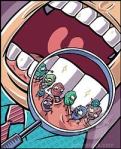
Bugs are having a party in your mouth without your consent. What will you do?? It starts with diet and then hygiene.
Oranges, kiwis, strawberries, limes, and peppers can all help your oral health. There are several different types of bacteria in your child’s mouth, and yours too! Some of them can cause gingivitis, which is the first stage of gum disease. Vitamin C in fruits such as oranges, limes, kiwis, cantaloupe, papaya, and strawberries helps kill these bacteria, and it also promotes a healthy supply of collagen in the gums. However, Dr Todd Snyder, DDS (Laguna Niguel, CA) says that kids and adults should rinse their mouths immediately with water and wait at least 30 minutes before brushing their teeth after having citrus foods or drinks. That’s because citric acid in the fruit can temporarily weaken tooth enamel and leave teeth vulnerable to erosion caused by brushing. Rinsing the mouth quickly can minimize the acid attack on the teeth. Other good vegetable sources: red, yellow, and orange peppers; tomatoes; and sweet potatoes.
Starchy carbohydrates like bread, white potatoes, and pasta break down into sugar. This sugar feeds other types of bacteria in your child’s mouth that produce cavity-causing acid. When you or your child drinks milk or eats yogurt or cheese — which are rich in calcium, vitamin D, and phosphate — it raises the pH level in his mouth, lowers acid levels, and reduces the risk of tooth decay. Calcium is also beneficial in several other ways: It mixes with plaque and sticks to teeth, further protecting them from lingering acid; it repairs damaged enamel; and it strengthens the bones around your child’s teeth, making them more resistant to periodontal disease later in life. Raw carrots, celery, cauliflower, green beans, and snap peas Crisp veggies are “chewing foods” that mechanically clean your child’s teeth and gums. These foods naturally scrape away plaque that builds up between meals or that kids miss when brushing. Encourage your child to eat slowly and to completely chew each crunchy mouthful. Sesame, sunflower, and pumpkin seeds, and nuts Nuts and seeds contain natural fats that coat teeth and help shield against bacteria. The oils in the seeds help strengthen enamel, making teeth more resistant to cavities, and most seeds also contain calcium. Kids older than 4 can eat trail mix as a healthy snack. Sugarless gum The next time your child begs for a pack in the checkout line, you can say yes. Saliva loosens plaque, increases the number of natural antibodies in the mouth, and keep gums hydrated. Chewing any food stimulates saliva production, but chewing sugarless gum for 20 minutes after meals can help prevent tooth decay, according to the American Dental Association (ADA). In fact, the ADA recently gave its Seal of Acceptance to Orbit, Extra, and Eclipse gums after Wrigley conducted studies demonstrating its brands’ benefits. However, kids shouldn’t chew gum until at least age 4, when you can trust them not to swallow it.
Go out and have fun eating while keeping away the potential for decay and gum disease.